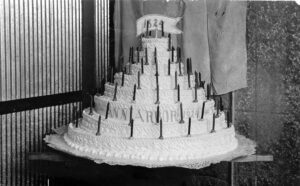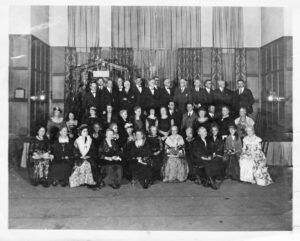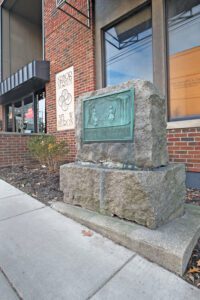On February 27, 1924, Ann Arbor celebrated its first centennial with a big birthday party at the Michigan Union attended by 588 people. This year, for the 200th anniversary, numerous events are being organized throughout the year by a diverse mix of groups.
By 1924 Ann Arbor had a lot to celebrate: the 100th anniversary of its founding in 1824 by John Allen and Elisha Rumsey. Allen was from Virginia and Rumsey from New York, and each was escaping from problems back east.

In 1924, descendants of the city’s earliest families posed for a photo and shared a cake with 100 candles. | Photos via: Orlando Stephenson, Ann Arbor: The First Hundred Years

Rumsey died in 1827 and Allen left for New York City in 1836, just in time to see his fortune disappear in the Panic of 1837. But thanks to their foresight in getting Ann Arbor designated as the county seat, and other developers’ successful wooing of the University of Michigan, the city thrived.
At the time of the centennial, Ann Arbor was dominated by two groups: people connected with the university and townsfolk, predominantly of German origin, who operated the stores and businesses. University people usually lived east of campus in what is now Burns Park, while the Germans lived near downtown in what is now known as the Old West Side.
In planning the 100th birthday party, the Ann Arbor Chamber of Commerce made sure both groups were represented: In addition to chamber president Barkley Butler and secretary Durand W. Springer, they recruited Titus Hutzel, of Hutzel Plumbing, and Alfred H. White, an assistant professor at the university. “The great success of the evening was due to the untiring efforts of these persons,” wrote U-M professor Orlando Stephenson in his book Ann Arbor, The First Hundred Years.
—
On the night of the big event, the four organizers sat at the speakers’ table, joined by U-M president Marion Burton and his wife, and Ann Arbor mayor George Lewis with his wife. (In 1924 newspaper articles rarely, if ever, designated wives by their first names.)
Attendees were seated in the order in which their ancestors came to Ann Arbor, with the earliest closest to the speakers’ table. The descendants were called to stand up one by one. The loudest applause was for the thirty-one descendants of Jonathan Henry Mann, who had come in 1829, and the fifty-seven descendants of Frederick Staebler, who came the next year.
Leonard Barrett, pastor of the First Presbyterian Church, gave the invocation, after which dinner was served. The menu was 1924-elegant: fruit cup salad, corn pudding, celery and olives, roast chicken, browned sweet potatoes, and lettuce and tomato salad with Thousand Island dressing. It ended with ice cream, coffee, and a 240-pound cake. The cake had eight tiers, each donated by a different local baker, and was lit with 100 candles.
Harry Hutchins, president emeritus of the university, introduced the speakers. First, Mayor Lewis talked about “Ann Arbor Today,” then Stephenson on “Ann Arbor 100 years ago,” and President Burton on “Civic Pride.” The speeches were interspaced with soloists and quartets singing old-time American songs, and the evening ended with all in attendance singing “Auld Lang Syne” and “Home Sweet Home.”
—

This error-filled historic marker at 315 W. Huron will remain, but a new one nearby will correct it. | Photos: Mark Bialek

Plans for Ann Arbor’s 200th birthday celebration are much more elaborate than the 100th. It starts on January 19 with a kickoff celebration at the Michigan Theater (see note below). Additional activities are scheduled all year long and reflect a population that is both much larger and much more diverse.
The planning committee has seventeen members, eight men and nine women, representing a variety of backgrounds and interests. “It’s a grassroots effort,” says member Christine Crockett. “We tried to involve as many different groups as possible in order to plan events.”
So far twelve activities are planned with the possibility of more being developed during the year. They include online, walking, and bus tours of historic neighborhoods, collecting oral histories, putting up more historical markers, and studying a variety of topics ranging from the women of Kempf House to the history of peace and nonviolent activism.
In one case a marker will be put up to correct an existing one. A plaque in front of 315 W. Huron St. shows the founders’ wives, Ann Allen and Mary Ann Rumsey, sitting together in an arbor. The text claims the women “met frequently for rest and recreation” beneath a “rustic grape arbor.”
The legend that the city took its name from a grape arbor was perpetuated for many years on the city seal, but while “Ann” is certainly a tribute to the founders’ wives, “arbor” is now understood as a reference to the existing clearings that attracted them to the site. The plan is to leave it up as a historical artifact, but to put a new one under it to explain the correct history.
Although Ann Arbor city government passed on taking a lead role in the bicentennial planning, it is renaming Southeast Area Park to Bicentennial Park for the occasion and putting in improvements including a splash pool, sculpture garden, and new shelter. More information is available on the Ann Arbor Bicentennial website, a2bicentennial.org.
The bicentennial celebration kicks off January 19 with an event emceed by bestselling local author John U. Bacon and featuring U-M School of Music, Theatre & Dance prof Aaron Dworkin reading his poem written for the occasion. Proceeds benefit Bicentennial Park and the James L. Crawford Elks Lodge. 6–8 p.m., Michigan Theater. $50, preregistration required at tinyurl.com/a2bicenkickoff.

Why in the world would anyone ever want to live anywhere else?